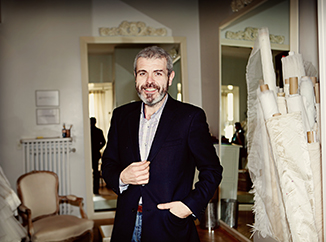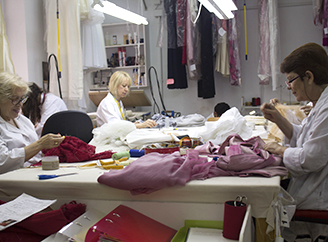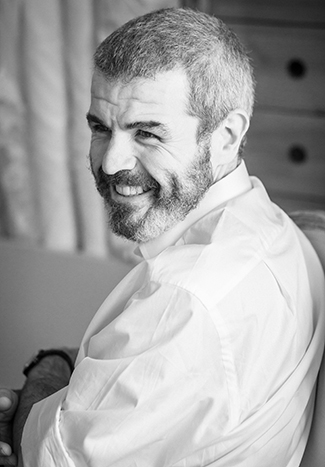consent_cookie
Duración: 1 year
Stores the user's cookie consent state
11-01-2017
Lorenzo Caprile welcomes us at his workshop in Barrio Salamanca, Madrid. He is charming and willing to talk in detail about his work, secondhand fashion, fastfashion ...
Who is and how did Lorenzo Caprile start in fashion?
I started very young because it is my vocation. I do not know how old I am ... 13 or 14 when I did my first practice. Who I am? A Madrid dressmaker who tries to do his job the best he can. With own workshop, which is very rare nowadays. Although it is a pale shadow of what they were before, with 200 or 300 people sewing and here we are twelve or thirteen.
How would you define your work, beyond the qualification of 'real fashion designer'?
Very handmade, very careful, at the service of my clients who are the ones who pay. My goal is always to be happy and another ten to go to make this work.
How do you see that 'bubble' of influencers, bloggers ...?
Well, what you say is a bubble. But I do not think it is wrong: in the end, fashion is that: play, make mistakes, experience. In that sense I differ a lot between bloggers who take the fashion very seriously and they seem to be talking about risk premium and others who take it with a hint of humor, they know they are talking about something that is in End, rather inconsequential. That series of nuances does appreciate them. I think fashion if you do not have a sense of humor, irony, ... when you take yourself too seriously, it becomes heavy, since it goes against your own essence. Fashion is fun, frivolous. To make you happy and to make others happy with your appearance. Going to Humana Shops is a cure for humility, because you see all the brands, from the most humble to the most expensive, all put together, on a coat rack, all democratically exposed. No longer does it count if they were in a shop in Lista or Avenue Montaigne. Count whether the product likes or dislikes.
Now that you talk about our stores, how did you find them?
Many years ago. The first store I entered was Atocha, 68, which was the first of Humana's in Madrid. I'm talking about ... maybe 15 years or more.
We like your definition of our stores: 'democratize the brands'. Have you found 'Capriles' in our Shops?
Yes, only a few times, but I have found them. Once or twice. You learn a lot too, because you see the brands: the ones you see in Humana are the ones that sell the most. Sometimes we are the comments of the press, all those media bubbles that are inflating and the reality is another. In Humana the marks you see, if they are there, means that people have bought them.
Humana stores are a reflection of what people consume ... in another temporary space, but that's what they buy ...
Yes, I think so.
We know you shop a lot in our stores ...
I buy a lot for myself and also in your competition, in cities like Berlin.
In Berlin there are Humana shops ..
Yes, I know. There is one that is gigantic, at Alexanderplatz, that I got an anxiety attack when I saw it. I also buy Humana for my theater projects or for my vintage clothing collection. If like me, you go a lot and you have relationship with the equipment of the store, they know what you are interested when it arrives to them. The last theatrical project that I have done, with November, is a Ricardo III, with Humana clothes.
What is sustainable fashion for you?
For my 'sustaining' sustainable fashion, worth the redundancy, is to buy from time to time new clothes, on sale, in the shops near my workshop, because they are my friends. Most of the clothes I buy are second-hand. From Humana, from the trail, from other secondhand stores, lots of inherited garments. The clothes, for example, here in the workshop I changed the buttons. Pants, jerseys ... the unisex clothes belong to my mother. But new clothes ... once a year on sale.
From your position as a designer, how do you see Zara, H & M, Primark ...?
Brilliant. I have always defended them in a cloak and a sword ... as a concept, an eye. If you begin to make a slight reflection on the prices of those chains, you can get a little hair on end. I do not want to be put on another black list, but there are certain clothes that do not fit, there is something that is not working at all well. Because there are clothes, which are a pass, by their materials, by how they are made, how they feel ... that they can not have this price. There is a chain link that is failing. But as a concept, it seems phenomenal because they have broken the legend that to dress well you have to spend a lot. Another aspect is how they have shortened the times, how they have suppressed the intermediaries, representatives, owners of show rooms, boutiques ... the message that arrived from the signature to the consumer was adulterated by these intermediaries. And there was also a lot of it in the price, which was expensive. In new clothes, very little. On a trip, you give yourself a whim. Most of the clothes I use are second hand. You can say it in the workshop, I'm always bringing things that we transform, with a pocket, changing the buttons ...
How do you see Spanish fashion versus Italian, for example?
I see her very well. For a start, what is fashion? For me, it's the whole spectrum, from the Humana stores to the super-luxury establishments on Lista Street. In that sense, Spanish fashion enjoys excellent health. The industrial group that has changed the rules of the game is Spanish: Inditex. And there are Mango, Pronovias and Rosa Clara, there is the Spanish shoe factory, the Puig group, Tous, Textilonia, Bimba and Lola, CH and Purificación García, Adolfo Domínguez and Roberto Verino. Realities like Scalpers, El Ganso, that has been absorbed by LVHM ... in that sense the Spanish fashion enjoys very good health. The problem is that for many chicks the fashion is only the author, the signed and nothing further from reality. And in that sense in Spain we have not stressed, for many reasons that would be very long to detail. We excel in football, cinema, cooking, sport, but in this sector of fashion signed author none of us is known outside here, but nothing happens.
Is marketing wrong?
It is a very old problem, which has to do with politics, governments, things that were done in the 1980s, which might have been done differently.
What do you mean?
To the subsidies, of which I am totally against. If you get used to doing what you do at the end of the year you are going to have a little money, you do nothing. The human being is lazy by nature. And in fashion you can not be lazy, you have to be constantly moving, reinventing yourself, learning, recycling, seeing things, an exhibition in the Metropolitan or a Humana store to get ideas, something I bought you, draw a pattern. You can not sleep on your laurels because the consumer society goes much faster than you. If you have been accustomed to doing what you do, well, bad, your parade will have you paid, you do not strive.
Guillermo del Toro said that the first film of a promising director deserves a grant. But never the second, because it will be the public that judges.
Totally agree with Guillermo. Especially because there are many ways to encourage and subsidize. It could be transformed into a prize that sells more, can export, or help to create a store in London. Now, in skinny cows everything has been resized and not as scandalous as 15 or 20 years ago. There was a time ... that's why that war of parades between Madrid and Barcelona: 'Here I get paid more, here less.' That's why one season paraded on one side and another on another. But, and those collections ...
Nor have they been produced or sold, and why? I go back to the old: These names 'cibeleros', in Humana, I can not find any. You see a lot of Felipe Varela, all the lines of El Corte Inglés, Inditex, Mango, small Spanish brands of all life, a lot of homemade dressmaking ... but the names 'cibeleros' ... sometime some Victorio & Lucchino Of party but of all the others ... to none. Yes I have seen things of mine and things from other colleagues who have these kinds of workshops, such as Petro, Eduardo, Jorge Vázquez and even Navascués or Teresa Palazuelo.
They are collections that have paraded, have made the show, but have not come to society. They have stayed in an aesthetic exercise. Logically they have charged for the parade. But for me the fashion is that your work serves something. In design schools I say: if you want to be an artist and change the world, change your clothes. Because if you want to express something with your work there are other ways of doing it like painting, cinema, literature, politics, but with the clothes, no. I do not know anyone who has changed their lives by buying clothes or seeing a beautiful parade.
Then the haute couture, for you is ...
It is a wonderful sight that can be afforded by the four, five or six large houses that still continue to do so. It is a publicity spot twice a year, to the beast and serves for duty free instead of buying a brand x buy Valentino or Chanel because it is a name with which you have crushed with images, with news. They are a great show.


